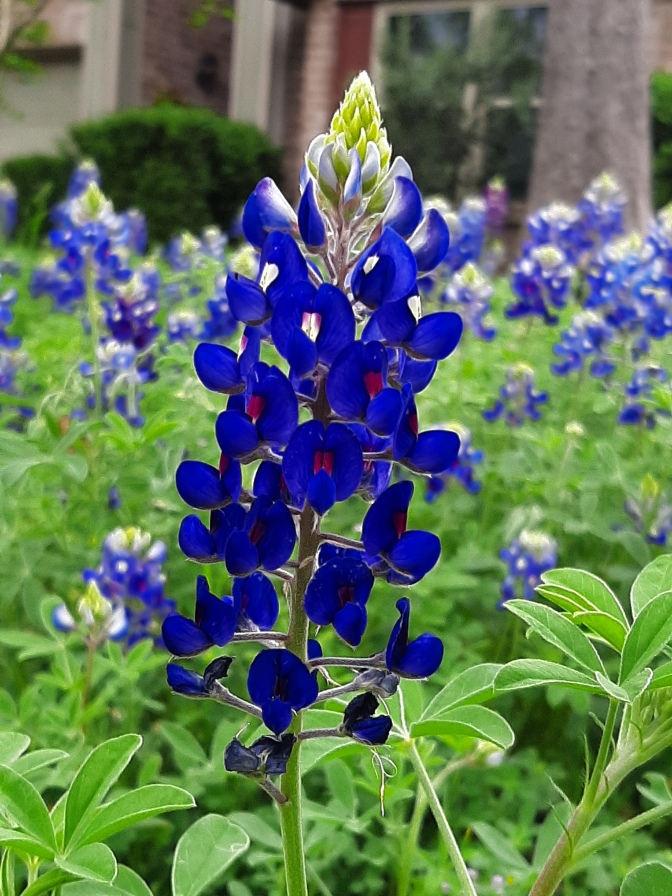Published in the Austin American-Statesman on May 29, 2022.
What would you do if you won a beautiful handmade bluebonnet quilt? I was recently faced with such a question after winning the main prize of our church’s raffle fundraiser. A few fellow church members ribbed me for winning, as if a pastor was ineligible to win. Ha—I paid for my raffle tickets like everyone else and was happy to support our congregation’s food pantry, one destination for the funds.



As I explained in a subsequent sermon message, it was appropriate that I won since I’m known as the “bluebonnet guy” in our neighborhood. We have a semi-xeriscape yard and each spring it draws onlookers with its array of cobalt bluebonnets and crimson and pink poppies. Even the Davis Lane median behind our house boasts of bluebonnets because I’ve sown seeds there. In May and June when the bluebonnets in nearby South Austin public spaces seed out, I turn into Robin Hood and equitably distribute seeds to other nearby locales that need a burst of spring color.
Many Texans are unaware that bluebonnets start their growing cycle each fall as rains coax seeds from the previous season to sprout. The little plants can handle adversity—cold weather, even snow and ice, as they lay low from October to February. Ponder for a moment that most all of the Central Texas bluebonnet blooms we saw in 2021 came from plants that endured the week-long February freeze and snow cover. The bluebonnet is not only a cherished and beautiful plant, it’s a wise teacher of life’s ability to withstand and overcome adversity.
We need its teaching example, especially now. As if two years of the pandemic weren’t enough, a horrible and brutal invasion of a peaceful nation by its bullying neighbor has created gloom and anxiety for those of us following the news from afar.
In the third chapter of the book of Lamentations, the prophet Jeremiah writes about his people’s exile from their beloved Jerusalem as it fell to the invading Babylonian army. He chronicles the affliction he saw—people chained and crying for help, their teeth ground into the dirt and gravel, people forgetting what happiness and prosperity were. The invasion was brutal, hateful, and ugly.
It wasn’t, however, the end of the story. The prophet purposely recalled promises as a way to mitigate the destruction and misery that he and his people experienced. “The steadfast love of the Lord never ceases, his mercies never come to an end; they are new every morning; great is your faithfulness . . . I will hope in him.”
For the prophet, remembering God’s past goodness and love was a way to help his people survive the onslaught of doubt, anxiety, and fear that adversity brought. Remembering God’s past goodness and love gave hope for tomorrow and the strength to act in the moment to counter adversity’s multiple effects.
Seeing bluebonnet blooms in the spring, I think, tells a similar story of life and beauty flourishing in the face of adversity. Again, this year, most of the bluebonnet blooms we currently see around Austin are from plants that survived a blanket of snow and ice in February.
My two-year-old granddaughter will be the recipient of the beautiful bluebonnet quilt, crafted by Diane McGowan of Abiding Love Lutheran Church. Diane is a retired AISD high school math teacher and co-founder of our church’s food pantry, a ministry that has provided nutrition and encouragement for individuals and families dealing with the adverse effects of living in poverty. This gift will give me the opportunity to teach my granddaughter, a young Central Texan, about the beautiful flowers she sees each spring in her grandparents’ yard and elsewhere. As she gets older and the quilt continues to keep her warm during the winter months, its beautiful images and patterns will remind her of spring’s promise—life, beauty, and vitality emerging on the heels of winter’s snow and ice.

T. Carlos “Tim” Anderson – I’m a Protestant minister and Director of Community Development for Austin City Lutherans (ACL), an organization of a dozen ELCA (Evangelical Lutheran Church in America) congregations in Austin, Texas. I’m the author of There is a Balm in Huntsville: A True Story of Tragedy and Restoration from the Heart of the Texas Prison System (Walnut Street Books, 2019). Readers describe it as “compelling,” “inspiring,” and “well written.”
I’m also the author of Just a Little Bit More: The Culture of Excess and the Fate of the Common Good (ACTA-Chicago, 2014), which traces the history of economic inequality in American society. Reviewing Just a Little Bit More, journalist Sam Pizzigati says, “Anderson, above all, writes with a purpose. He’s hoping to help Americans understand that an egalitarian ideal helped create the United States. We need that ideal, Anderson helps us see, now more than ever.”


Good one, Pastor Tim/T. Carlos. Hope you are doing well. Jud
Sent from my iPad
>
LikeLike
Appreciate it, Jud! Hanging in there here . . . hope the same for you guys.
LikeLike
Beautifully written! Love the bluebonnets!
Lucy
Sent from my iPhone
>
LikeLike
Enjoyed the sermon Tim. Thanks. Enjoy the beautiful quilt.
LikeLike